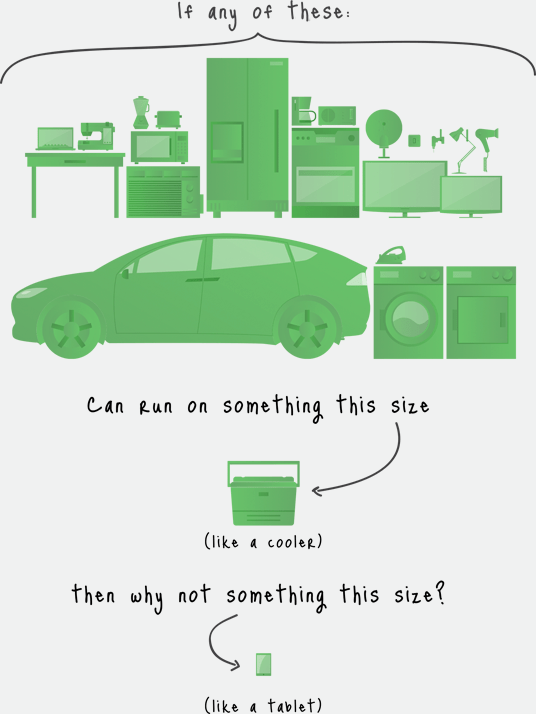Can you imagine 2,000 watts of alternating current electrical power coming out of a device no larger than a small laptop?
For comparison’s sake, today’s 15-inch laptops consume a mere 40 – 65 watts (using an external power brick). Now Google wants something the size of laptop, hooked to a solar array, to produce up to 40 times more power in the same physical envelope.
And the company’s betting $1,000,000 it can be done in about 18 months.
Getting AC (alternating current) out of DC (direct current) is the job of a power inverter. Much of our domestic world relies on AC. And AC needs robust power distribution grids, huge power plants and either fossil fuel, nuclear power, or falling water.
It’s not difficult to envision a world where AC comes instead from solar grids generating copious amounts of DC, which is then processed by inverters to run our homes, factories, businesses, and more. It’s green thinking. But is it also blue sky thinking?
Today’s inverters take up about as much space as a good-sized picnic cooler, often larger. Why this large? Seeking answers, Google has partnered with the Institute of Electrical and Electronic Engineers (IEEE) Power Electronics Society to mount a $1 million “Littlebox Challenge,” hopefully retiring the question with a new category of highly efficient power inverter.
“We are very pleased to present this important initiative together with Google to encourage innovation. By participating in this challenge, members of industry and academia can play a pivotal role in a technological innovation that could have a major impact on the world,” said IEEE PELS President Don Tan.The contest begins this week.
Here’s the challenge to engineers everywhere: Design and build a 1,000-watt minimum inverter with the highest power density (at least 50 watts per cubic inch). Can you do it?
“Cooler sized isn’t cool,” headlines the promotion:
Inverters are the essential boxes that take direct current from devices such as solar panels and batteries and turn it into alternating current for use in homes, businesses and cars.
The problem is household inverters are too big — roughly the size of a picnic cooler. Making them smaller would enable more solar-powered homes, more efficient distributed electrical grids, and could help bring electricity to the most remote parts of the planet.
That’s where you come in: figure out how to shrink an inverter down to something smaller than a small laptop (a reduction of >10X in volume) and smaller than everyone else, and you’ll win a million dollars (and help revolutionize electricity for the next century).
VB was curious about Google’s interests. Here’s what we were told:
We believe that inverters will become increasingly important to our economy and environment as solar PV, batteries, and similar power sources continue their rapid growth. More broadly, similar forms of power electronics are everywhere: in laptops, phones, motors drives, electric vehicles, wind turbines, to give just a few examples. We expect that the innovations inspired by this prize will have wide applicability across these areas, increasing efficiency, driving down costs, and opening up new users cases that we can’t imagine today. It also doesn’t hurt that many of these improvements could make our data centers run more safely and efficiently.
Google’s partner, the IEEE, “is the world’s largest professional association dedicated to advancing technological innovation and excellence for the benefit of humanity,” says the organization. The IEEE Power Electronics Society (PELS) has guided development and innovation in power electronics technology for over 25 years. PELS will assist in judging and overseeing the competition.
To enter, go to the website and click the Register link. Be sure to surf around, paying attention to What the Inverter Needs to Do under Technical Details. Also read the FAQ’s Here’s the contest calendar:
September 2014
- Applicants contemplating competing in the prize must register their team by the registration deadline: September 30, 2014.
- Eligible academics interested in pursuing grant funding must apply by the grant application deadline: September 30, 2014 by visiting the University Relations site.
July 2015
- Registered teams must submit a technical approach and testing application by July 22, 2015.
October 2015
- Up to 18 finalists will be notified of their selection for final testing at the testing facility. They are required to bring their inverters in person to a testing facility in United States by October 21, 2015.
January 2016
- The grand prize winner will be announced sometime in January, 2016.
What’s next? Once the inverter challenge is solved, perhaps Google will champion the elimination of all those “wall wart” chargers that festoon our mobile lives. Or at least figure out how to turn them completely off when charging goes inactive.


